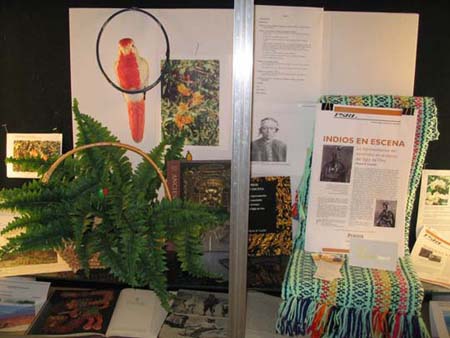Indios en escena: La representación del amerindio en el teatro del Siglo de Oro
Moisés R. Castillo
Indios en escena engages both the Baroque and Colonial fields of Hispanism in order to reevaluate fourteen major plays of Spanish Golden Age literature from a social-historical perspective. Castillo argues that these plays portray Amerindians not in their “otherness” but as subjects of empire. It is the author’s contention that these dramas reveal the vast contradictions between the two leading ideological trends of the age as performed on the stage: the discourse of honor and the juridical-theological code, both of which attempt to assimilate the Amerindian phenomenon under the auspices of church and state. These works consistently raise the paradoxical question of how a person can be a savage and have honor at the same time. The Amerindian must become a new “subject” for the Spanish Crown (as stated by the discourse of honor in these plays), i.e., an honorable and distinguished Indian capable of lofty speech and courage in battle. Yet, Amerindians are also barbarians or wild “children” (F. de Vitoria, Las Casas) who need the redemptive intervention of the Church to mature (evolve) and to be capable of salvation. These plays reveal the effort to integrate and assimilate the new indigenous entities under the monarcho-seigneurial system while exposing the philosophical contradictions that Baroque ideology has to overcome in order to elicit obedience. Thus, Castillo claims that this theater propagates the concept of the “Amerindian” both as “Honorable Subject,” a theatrical archetype, and idolatrous barbarian “Other,” a model of representation that belongs to the mindset of religious crusades and evangelical enterprises.
“… a compelling view of both dramatic production and philosophical debates about indigenous people as a key intellectual milieu of the time. … transatlantic in approach and impact … The fact that Castillo never loses sight of this essential distinction [between representation of the indigenous people and representation of the Spanish Empire and its colonialist ideology] indicates the critical rigor and predicts the scholarly purchase Indios en escena will continue to have in the coming years." —Jorge Coronado, MLN, Hispanic Issue (2011): 416-18.
“… no solo ayuda a entender la transformación de la imagen del indio en un período clave de las letras del Barroco, sino que a la vez permite indagar en los modos de apropiación y recreación de temas americanos por una serie de autores menos conocidos, pero de singular importancia para tener una clara visión del fenómeno teatral español del siglo XVII y sus relaciones con los habitantes de América.” —Juan Vitulli, Hispanic Review (Autumn 2011): 679-82.
“… el trabajo es muy sólido y erudito … Con la ventaja de no tener deudas políticas visibles, nuestro investigador supera a sus predecesores en finura interpretativa y en equilibrio ideológico, además de emplear un tono elegante y nada polémico.” —Héctor Brioso Santos, Criticón 111-12 (2011): 310-14.
“Este libro es uno de los estudios más equilibrados, mejor documentados y más iluminadores que, en mi opinión, se han publicado hasta la fecha sobre la representación del personaje indígena americano.” —José María Ruano de la Haza, Revista de Estudios Hispánicos 45.1 (Winter 2011): 227-29.
“… es justamente una lectura indispensable para quienes estudiamos el teatro del Siglo de Oro, así como para quienes valoramos la historia de América.” —A. Robert Lauer, University of Oklahoma, TEATRO-L@LISTS.OU.EDU TEATRO-L Archives, 31 Dec. 2010.
“An exhaustively researched study that fleshes out the fluctuating religiously and politically influenced image of the New World natives as well as that of Spaniards in the ‘conquest plays’ of Spanish Golden Age Theater.” —Bonnie Gasior, California State University, Long Beach
“Al leer Indios en escena se percibe la pasión y el entusiasmo de un serio investigador del tema. Es una obra excelente para los amantes del teatro del Siglo de Oro español y su problemática, que se dirige tanto a los especialistas como a los alumnos avanzados de las comedias barrocas de tema amerindio.” —Beatrice Giannandrea, Hispania 94 (Dec. 2011): 757–58.
“[Es] un libro que resultará fundamental a la hora de comprender los mecanismos dramáticos de asimilación del otro en la escena áurea. Indios en escena nos recuerda que, a pesar de ser un arquetipo minoritario dentro de una inmensa producción dramática, el amerindio tuvo su interés para todos y cada uno de los grandes ingenios del momento.”—Enrique García Santo-Tomás, University of Michigan, Revista Iberoamericana 77.240 (2012): 722-24.
Moisés R. Castillo, University of Kentucky, is a native of Granada, Spain. He has published articles on Golden Age theater in journals such as Bulletin of the Comediantes and Theatralia: Revista de Poética del Teatro. His current research focuses on the representation of Amerindians, Jews, and Muslims in the theater of the Spanish Baroque.
978-1-55753-539-9 In Spanish.
2009.Vol. 48. x, 365 pp. Paper $43.95


Display case in Stanley Coulter Hall, week of January 11-15, 2010
cómo el amerindio puede ser considerado a la vez un ser "honorable" y "bárbaro" en
versos contiguos dentro de una misma obra dramática."
—Moisés Castillo, page 2
Information last updated August 17, 2018.
For further information about this book, contact the production editor at psrl@purdue.edu